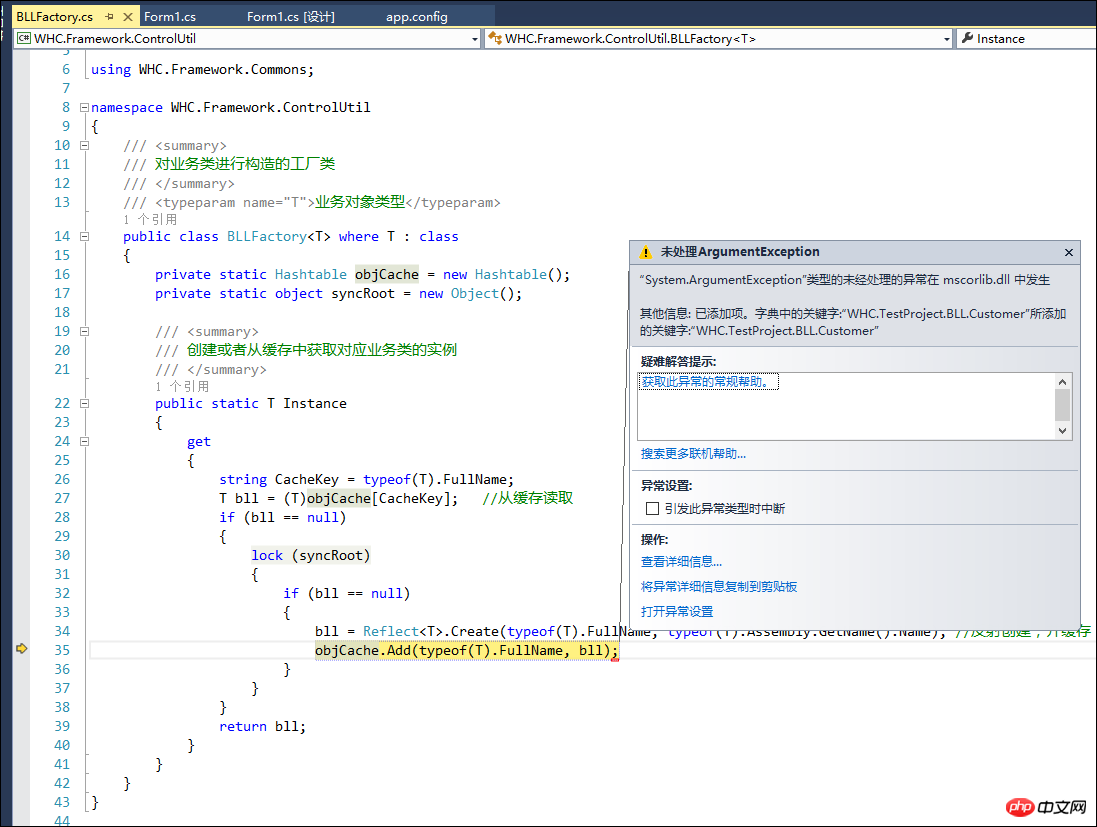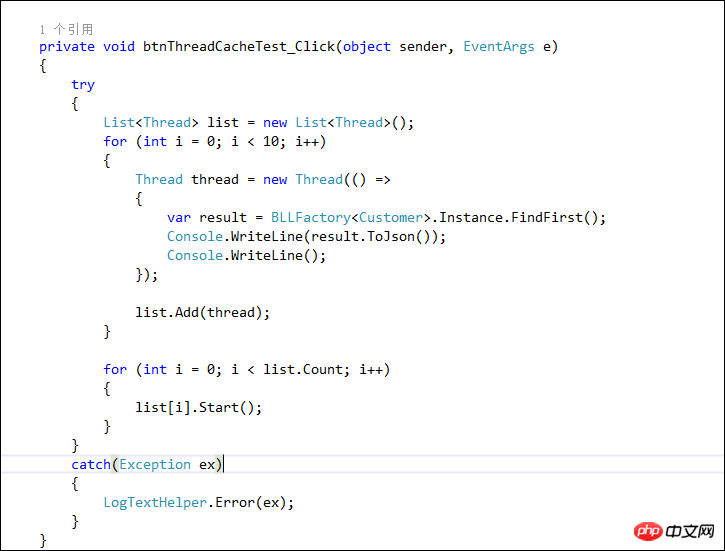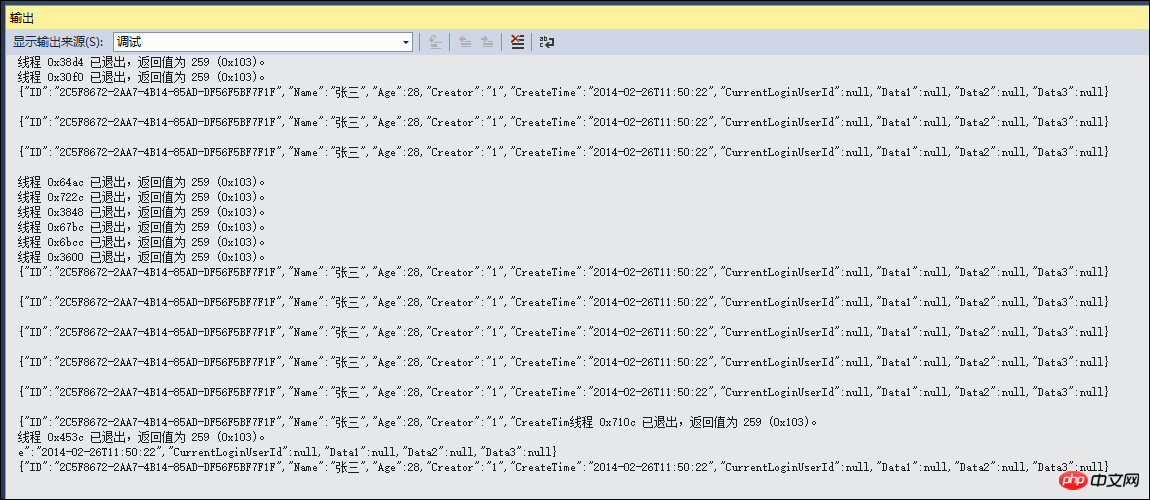 Backend Development
Backend Development
 C#.Net Tutorial
C#.Net Tutorial
 Detailed explanation of using ConcurrentDictionary multi-thread synchronization dictionary collection example
Detailed explanation of using ConcurrentDictionary multi-thread synchronization dictionary collection example
Detailed explanation of using ConcurrentDictionary multi-thread synchronization dictionary collection example
In the past period of time, most of my base classes used a combination of lock and Hashtable to implement conflict handling for caches in multi-threads. However, sometimes using these two combinations was not satisfactory. Occasionally, the collection has been added. Exception, the problem remained the same after multiple processing of the code. Finally, the ConcurrentDictionary multi-threaded synchronized dictionary collection introduced after .NET 4.0 was used, and the problem was successfully solved.
1. Use lock and Hashtable combination to achieve
In my base class, build the business object. Generally, you can use BLLFactory
var result = BLLFactory<Customer>.Instance.FindFirst(); Console.WriteLine(result.ToJson());
So after using BLLFactory
HashTable represents a collection of key/value pairs. In the .NET Framework, Hashtable is a container provided by the System.Collections namespace. It is used to process and represent key-value pairs. The key can usually be used for quick search, and the key is case-sensitive; the value is used for Store the value corresponding to key. The key-value pairs in Hashtable are all of object type, so Hashtable can support any type of key-value pair, and any non-null object can be used as a key or value.
Using this method, occasionally multi-threaded access conflicts still occur on the Web side. For this reason, we can also use multi-threaded test code to test and reproduce the error,
try{
List<Thread> list = new List<Thread>();for (int i = 0; i < 10; i++)
{
Thread thread = new Thread(() =>{var result = BLLFactory<Customer>.Instance.FindFirst();
Console.WriteLine(result.ToJson());
Console.WriteLine();
});
list.Add(thread);
}for (int i = 0; i < list.Count; i++)
{
list[i].Start();
}
}catch(Exception ex)
{
LogTextHelper.Error(ex);
}The error message obtained by the tracking code is as follows.

Therefore, as you can see from the above code, multi-thread conflict problems cannot occur even with lock(syncRoot).
2. Use ConcurrentDictionary instead of Hashtable
ConcurrentDictionary is one of a set of thread-safe collections launched by .net4.0, and was released together with it. ConcurrentStack, ConcurrentQueue and other types, their single-threaded versions (thread-unsafe, Queue, Stack, Dictionary) will definitely be familiar to us. ConcurrentDictionary<TKey, TValue> can be accessed by multiple threads at the same time and is thread-safe. Its usage is the same as Dictionary, but with some more methods. ConcurrentDictionary belongs to the System.Collections.Concurrent namespace. The System.Collections.Concurrent namespace provides multiple thread-safe collection classes. When multiple threads are accessing a collection concurrently, these classes should be used instead of the corresponding types in the System.Collections and System.Collections.Generic namespaces ##. public bool TryAdd(TKey key, TValue value)public bool TryUpdate(TKey key, TValue newValue, TValue comparisonValue)public TValue this[TKey key] { get; set; }public TValue AddOrUpdate(TKey key, Func<TKey, TValue> addValueFactory, Func<TKey, TValue, TValue> updateValueFactory)
public TValue AddOrUpdate(TKey key, TValue addValue, Func<TKey, TValue, TValue> updateValueFactory)public TValue GetOrAdd(TKey key, TValue value)public TValue GetOrAdd(TKey key, Func<TKey, TValue> valueFactory) /// <summary>/// 对业务类进行构造的工厂类/// </summary>/// <typeparam name="T">业务对象类型</typeparam>public class BLLFactory<T> where T : class{//采用ConcurrentDictionary线程安全的集合类来缓存,替代Hashtableprivate static ConcurrentDictionary<string, object> conCurrentCache = new ConcurrentDictionary<string, object>(); /// <summary>/// 创建或者从缓存中获取对应业务类的实例/// </summary>public static T Instance
{get{string CacheKey = typeof(T).FullName;return (T)conCurrentCache.GetOrAdd(CacheKey, s =>{var bll = Reflect<T>.Create(typeof(T).FullName, typeof(T).Assembly.GetName().Name); //反射创建,并缓存return bll;
});
}
}
}

The above is the detailed content of Detailed explanation of using ConcurrentDictionary multi-thread synchronization dictionary collection example. For more information, please follow other related articles on the PHP Chinese website!

Hot AI Tools

Undresser.AI Undress
AI-powered app for creating realistic nude photos

AI Clothes Remover
Online AI tool for removing clothes from photos.

Undress AI Tool
Undress images for free

Clothoff.io
AI clothes remover

AI Hentai Generator
Generate AI Hentai for free.

Hot Article

Hot Tools

Notepad++7.3.1
Easy-to-use and free code editor

SublimeText3 Chinese version
Chinese version, very easy to use

Zend Studio 13.0.1
Powerful PHP integrated development environment

Dreamweaver CS6
Visual web development tools

SublimeText3 Mac version
God-level code editing software (SublimeText3)

Hot Topics
 1359
1359
 52
52
 What software is crystaldiskmark? -How to use crystaldiskmark?
Mar 18, 2024 pm 02:58 PM
What software is crystaldiskmark? -How to use crystaldiskmark?
Mar 18, 2024 pm 02:58 PM
CrystalDiskMark is a small HDD benchmark tool for hard drives that quickly measures sequential and random read/write speeds. Next, let the editor introduce CrystalDiskMark to you and how to use crystaldiskmark~ 1. Introduction to CrystalDiskMark CrystalDiskMark is a widely used disk performance testing tool used to evaluate the read and write speed and performance of mechanical hard drives and solid-state drives (SSD). Random I/O performance. It is a free Windows application and provides a user-friendly interface and various test modes to evaluate different aspects of hard drive performance and is widely used in hardware reviews
 How to download foobar2000? -How to use foobar2000
Mar 18, 2024 am 10:58 AM
How to download foobar2000? -How to use foobar2000
Mar 18, 2024 am 10:58 AM
foobar2000 is a software that can listen to music resources at any time. It brings you all kinds of music with lossless sound quality. The enhanced version of the music player allows you to get a more comprehensive and comfortable music experience. Its design concept is to play the advanced audio on the computer The device is transplanted to mobile phones to provide a more convenient and efficient music playback experience. The interface design is simple, clear and easy to use. It adopts a minimalist design style without too many decorations and cumbersome operations to get started quickly. It also supports a variety of skins and Theme, personalize settings according to your own preferences, and create an exclusive music player that supports the playback of multiple audio formats. It also supports the audio gain function to adjust the volume according to your own hearing conditions to avoid hearing damage caused by excessive volume. Next, let me help you
 How to use Baidu Netdisk app
Mar 27, 2024 pm 06:46 PM
How to use Baidu Netdisk app
Mar 27, 2024 pm 06:46 PM
Cloud storage has become an indispensable part of our daily life and work nowadays. As one of the leading cloud storage services in China, Baidu Netdisk has won the favor of a large number of users with its powerful storage functions, efficient transmission speed and convenient operation experience. And whether you want to back up important files, share information, watch videos online, or listen to music, Baidu Cloud Disk can meet your needs. However, many users may not understand the specific use method of Baidu Netdisk app, so this tutorial will introduce in detail how to use Baidu Netdisk app. Users who are still confused can follow this article to learn more. ! How to use Baidu Cloud Network Disk: 1. Installation First, when downloading and installing Baidu Cloud software, please select the custom installation option.
 How to use NetEase Mailbox Master
Mar 27, 2024 pm 05:32 PM
How to use NetEase Mailbox Master
Mar 27, 2024 pm 05:32 PM
NetEase Mailbox, as an email address widely used by Chinese netizens, has always won the trust of users with its stable and efficient services. NetEase Mailbox Master is an email software specially created for mobile phone users. It greatly simplifies the process of sending and receiving emails and makes our email processing more convenient. So how to use NetEase Mailbox Master, and what specific functions it has. Below, the editor of this site will give you a detailed introduction, hoping to help you! First, you can search and download the NetEase Mailbox Master app in the mobile app store. Search for "NetEase Mailbox Master" in App Store or Baidu Mobile Assistant, and then follow the prompts to install it. After the download and installation is completed, we open the NetEase email account and log in. The login interface is as shown below
 How to use Xiaoai Speaker How to connect Xiaoai Speaker to mobile phone
Feb 22, 2024 pm 05:19 PM
How to use Xiaoai Speaker How to connect Xiaoai Speaker to mobile phone
Feb 22, 2024 pm 05:19 PM
After long pressing the play button of the speaker, connect to wifi in the software and you can use it. Tutorial Applicable Model: Xiaomi 12 System: EMUI11.0 Version: Xiaoai Classmate 2.4.21 Analysis 1 First find the play button of the speaker, and press and hold to enter the network distribution mode. 2 Log in to your Xiaomi account in the Xiaoai Speaker software on your phone and click to add a new Xiaoai Speaker. 3. After entering the name and password of the wifi, you can call Xiao Ai to use it. Supplement: What functions does Xiaoai Speaker have? 1 Xiaoai Speaker has system functions, social functions, entertainment functions, knowledge functions, life functions, smart home, and training plans. Summary/Notes: The Xiao Ai App must be installed on your mobile phone in advance for easy connection and use.
 BTCC tutorial: How to bind and use MetaMask wallet on BTCC exchange?
Apr 26, 2024 am 09:40 AM
BTCC tutorial: How to bind and use MetaMask wallet on BTCC exchange?
Apr 26, 2024 am 09:40 AM
MetaMask (also called Little Fox Wallet in Chinese) is a free and well-received encryption wallet software. Currently, BTCC supports binding to the MetaMask wallet. After binding, you can use the MetaMask wallet to quickly log in, store value, buy coins, etc., and you can also get 20 USDT trial bonus for the first time binding. In the BTCCMetaMask wallet tutorial, we will introduce in detail how to register and use MetaMask, and how to bind and use the Little Fox wallet in BTCC. What is MetaMask wallet? With over 30 million users, MetaMask Little Fox Wallet is one of the most popular cryptocurrency wallets today. It is free to use and can be installed on the network as an extension
 Teach you how to use the new advanced features of iOS 17.4 'Stolen Device Protection'
Mar 10, 2024 pm 04:34 PM
Teach you how to use the new advanced features of iOS 17.4 'Stolen Device Protection'
Mar 10, 2024 pm 04:34 PM
Apple rolled out the iOS 17.4 update on Tuesday, bringing a slew of new features and fixes to iPhones. The update includes new emojis, and EU users will also be able to download them from other app stores. In addition, the update also strengthens the control of iPhone security and introduces more "Stolen Device Protection" setting options to provide users with more choices and protection. "iOS17.3 introduces the "Stolen Device Protection" function for the first time, adding extra security to users' sensitive information. When the user is away from home and other familiar places, this function requires the user to enter biometric information for the first time, and after one hour You must enter information again to access and change certain data, such as changing your Apple ID password or turning off stolen device protection.
 How to use Thunder to download magnet links
Feb 25, 2024 pm 12:51 PM
How to use Thunder to download magnet links
Feb 25, 2024 pm 12:51 PM
With the rapid development of network technology, our lives have also been greatly facilitated, one of which is the ability to download and share various resources through the network. In the process of downloading resources, magnet links have become a very common and convenient download method. So, how to use Thunder magnet links? Below, I will give you a detailed introduction. Xunlei is a very popular download tool that supports a variety of download methods, including magnet links. A magnet link can be understood as a download address through which we can obtain relevant information about resources.



